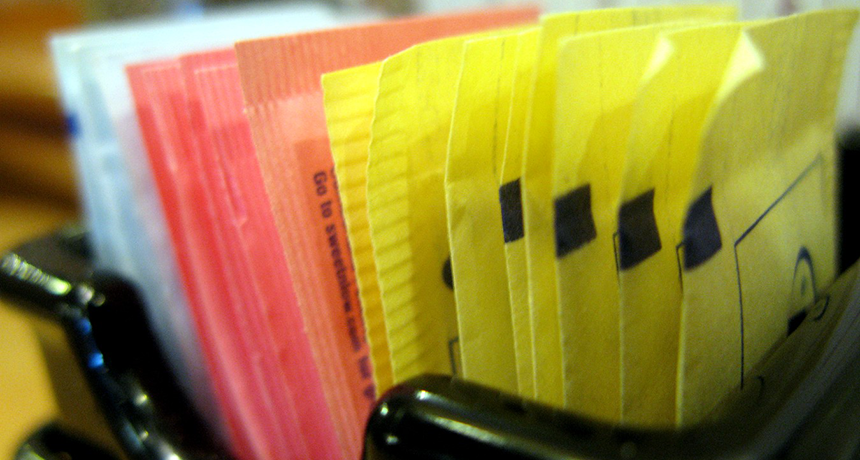When bitter + bitter = sweet
Saccharin and cyclamate can have a bitter aftertaste, but not when combined. Here’s why

Two artificial sweeteners are sweeter than one, and scientists finally know why.
frankieleon/Flickr (CC BY 2.0)
Artificial sweeteners can have a not-so-sweet side — a bitter aftertaste. Their flavors can be such a turnoff that some people never use them. Decades ago, people noticed something special about two of these artificial sweeteners:saccharin and cyclamate. Each tastes bitter on its own. But that bitterness disappears when they’re consumed together. At last, scientists know why.
On its own, each sweetener stimulates both sweet and bitter sensations. But when taken together, each sweetener blocks at least some of the other’s bitterness. The result could make your bitter soft drink better. And that could point scientists to the next super sweetener.
Our tongues are covered in receptors. These are molecules that serve as docking stations for certain chemicals. Tongue receptors are specific to various tastes: sweet, salty, sour, bitter and savory (also called umami).
Artificial sweeteners taste sweet because their chemical structure activates receptors on the tongue for sweet taste. Saccharin is 300 times as sweet as sugar. Cyclamate is 30 to 40 times sweeter than the real deal. Saccharin has been in use since its discovery in 1879. It’s best known as Sweet’N Low in the United States. Cyclamate was initially approved in the United States in 1951. But it was banned as a food additive in 1969 over concerns that it caused cancer in rats. It remains popular elsewhere. In fact, it’s the sweetener in Canada’s version of Sweet’N Low.
Yet many artificial sweeteners don’t activate just sweet receptors. Their structures tickle bitter receptors, too. The result is a sweet start but a bitter aftertaste. Saccharin and cyclamate both have bitter ends. In the 1950s, scientists realized that combiningthe two wasn’t nearly as bitter as was either by itself. The mixture is still available in Europe. There, it’s sold under brand names such as Assugrin.
But scientists didn’t know why the combo was such a sweet deal. One reason: Scientists simply didn’t know a lot about how we taste. The receptors for bitter flavors were only discovered in 2000, explains Maik Behrens. He works at the German Institute of Human Nutrition Potsdam-Rehbrűcke. There, he studies molecular biology — the role of molecules that are essential for life.
Over time, 25 different potential bitter-taste receptors have emerged. And science has shown that not everyone has the same levels of each type. That’s why some people may taste the bitterness in greens like broccoli more strongly, while other people are more bothered by artichokes or asparagus.
“A lucky chance”
Behrens and his colleagues Kristina Blank and Wolfgang Meyerhof wanted to find out which bitter-taste receptors saccharin and cyclamate trigger. To do that, the researchers examined the genes — or instructions for making molecules — for the 25 known subtypes of bitter receptors.
Human taste cells are difficult to work with in the lab. So the scientists inserted the taste genes into human kidney cells that were growing in dishes. Each gene came tagged with something called a reporter gene. This is a gene that scientists can look for to find out if it — and the gene it now partners — made it into the kidney cell’s DNA. The reporter gene glowed when the receptors it was in were stimulated. That let the researchers see exactly what was going on inside the cells.
Previous studies of the two sweeteners had shown that saccharin activates the bitter receptor subtypes 31 and 43. Cyclamate tickles subtypes 1 and 38. Stimulating any of those four subtypes will leave a bitter taste in your mouth.
But cyclamate doesn’t just activate the two bitter receptors, Behrens and his colleagues showed. It also blocks the bitter receptors that saccharin stimulates. Cyclamate slips into the space inside those bitter receptors and clogs it up. So with cyclamate around, saccharin can’t get at the bitter-taste receptors it normally triggers, Behrens explains. Bye-bye, bitter saccharin.
The reverse is also true, somewhat. Saccharin blocks subtype 1. That’s one of the bitter receptors that cyclamate turns on. But saccharin doesn’t block the receptor very well. In fact, you would need so much saccharin to completely block cyclamate’s bitterness that the saccharin’s own bitterness would become overwhelming. So it’s probably cyclamate blocking saccharin’s bitter receptors that makes the duo a sweet combination.
Behrens and his colleagues reported their findings September 14 in the journal Cell Chemical Biology.
The researchers also tested whether the combo would boost activation of sweet receptors. Alas, no. In combination, saccharin and cyclamate stayed just as sweet.
“This addresses a longstanding puzzle: why mixing two different sweeteners changes the aftertaste,” says Yuki Oka. “They are interrupting each other at the receptor level.” Oka studies the brain at the California Institute of Technology in Pasadena.
It’s not too surprising that a sweetener might block some receptors and stimulate others, he notes. But that saccharin and cyclamate complement each other so well is a lucky chance. In fact, he adds, “It’s surprisingly beautiful.”
No actual tongues tasted sweeteners in these tests, Oka notes. The tests took place on cells in dishes. And those cells contained human bitter-taste receptors. So it’s likely that the same thing happens when the combo hits a human tongue.
Behrens hopes the cells he developed can be used to predict how other sweeteners might interact. It might help scientists develop new, sweeter flavors. He has money to do this work from a large group of researchers and companies. Many of them will probably be very interested in any sweet results. And along the way, scientists may be able to resolve more taste mysteries of the past.







